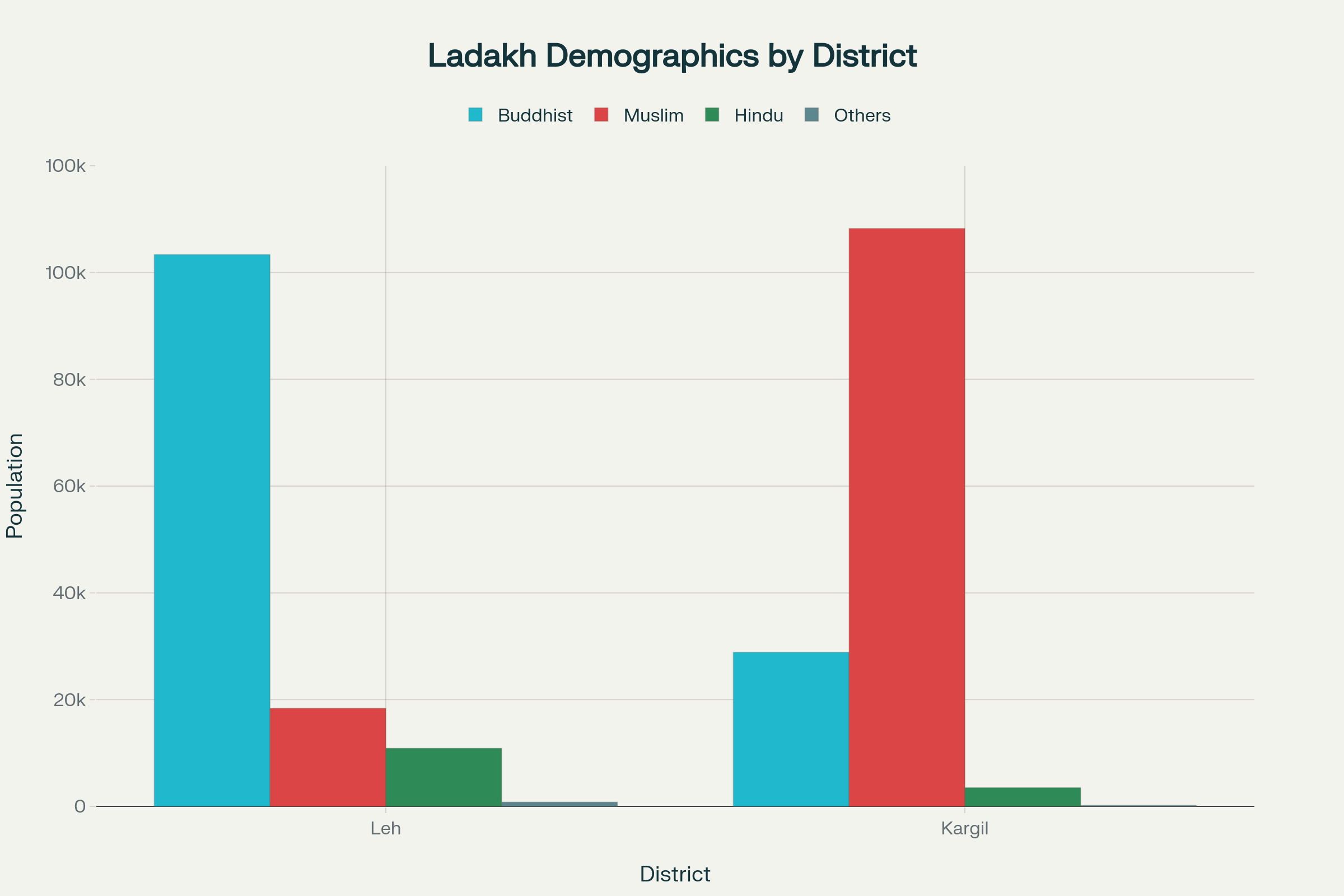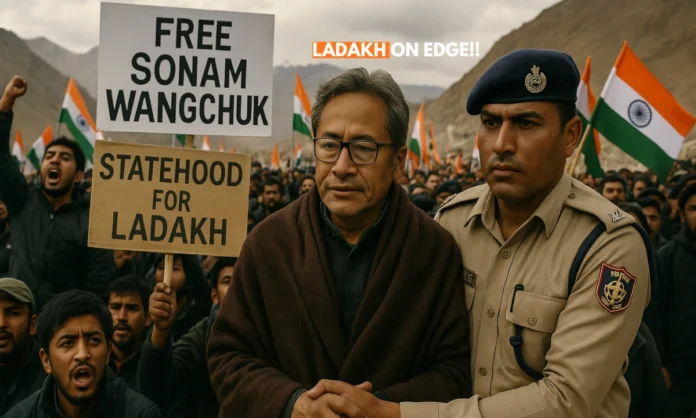Key Highlights
- Sonam Wangchuk detained under National Security Act following September 25 violence that claimed four lives in Leh
- Supreme Court issues notice to Centre and Ladakh Administration on habeas corpus petition filed by Wangchuk’s wife
- Activists demand independent judicial inquiry into killings and restoration of constitutional protections through Sixth Schedule inclusion
Sonam Wangchuk Detention: Opening Overview
The detention of renowned educator and climate activist Sonam Wangchuk under the National Security Act has thrust Ladakh’s statehood movement into national spotlight, raising critical questions about constitutional rights and democratic dissent in India’s strategically sensitive border region. Wangchuk’s arrest followed the deadliest protests in Ladakh in years, where security forces opened fire on September 25, 2025, killing four protesters demanding statehood and constitutional safeguards for the Union Territory. The Sonam Wangchuk detention case has become a flashpoint for broader tensions over Ladakh’s political status since the region was carved out as a separate Union Territory in 2019 following the abrogation of Article 370.
The escalation from peaceful protests to violent confrontations highlights the mounting frustration among Ladakh’s 304,000 residents, who have been demanding inclusion under the Sixth Schedule of the Constitution and full statehood since losing their legislative assembly in the 2019 reorganization. The Sonam Wangchuk detention under the stringent NSA, which allows preventive custody for up to 12 months without trial, has intensified concerns about the government’s approach to handling legitimate constitutional demands in the region.
Are heavens gonna fall if you share the detention order? How even we are gonna challenge & on what grounds?
— Ladakh (@Ladakhism) October 6, 2025
The govt. that detained Sonam Wangchuk at lightening speed is now adamant on withholding the very order citing baseless grounds. Guess why the govt. is so insecure? Any… https://t.co/X3DHI7k735 pic.twitter.com/9Gm2Hr6maL
Sonam Wangchuk Detention: Background to Constitutional Demands
Ladakh’s transformation from a region within Jammu and Kashmir to a Union Territory without legislative powers has created unprecedented governance challenges in the high-altitude desert region bordering China and Pakistan. The region’s unique demographic composition, with Leh district being predominantly Buddhist (77.30%) and Kargil district having a Muslim majority (76.87%), has historically maintained delicate communal harmony while pursuing shared political objectives.

The Leh Apex Body and Kargil Democratic Alliance have united in demanding constitutional protections that would safeguard land rights, job reservations for locals, and cultural preservation in the face of potential outside investment and demographic changes. These demands gained urgency after the government’s Article 240 regulations, while providing some job protections, fell short of the constitutionally guaranteed autonomy that Sixth Schedule status would provide.
Sonam Wangchuk Detention: September Violence and Government Response
The September 25 violence erupted after months of peaceful protests led by the Sonam Wangchuk movement, which included hunger strikes and community mobilization for statehood demands. Government sources alleged that Wangchuk’s “provocative statements” referencing Arab Spring-style protests and Gen Z movements in Nepal incited the violence that saw protesters torch the BJP office and government buildings in Leh.
The Home Ministry’s response was swift and comprehensive, imposing curfew, deploying additional security forces, and subsequently detaining Wangchuk under the NSA on September 26. The government also cancelled the FCRA registration of Wangchuk’s three-decade-old organization, the Students Educational and Cultural Movement of Ladakh, citing violations of foreign funding regulations.
Legal Battle and Supreme Court Intervention
The Sonam Wangchuk detention case reached the Supreme Court through a habeas corpus petition filed by his wife, Gitanjali J Angmo, challenging the legality of his preventive detention under Article 22 of the Constitution. The petition argues that the NSA detention violates constitutional provisions as the grounds of detention were not provided to family members, preventing them from mounting an effective legal challenge.
On October 5, 2025, a Supreme Court bench comprising Justice Aravind Kumar and Justice NV Anjaria issued notice to the Central Government, Ladakh Administration, and Jodhpur Central Jail Superintendent, scheduling the matter for hearing on October 14. Senior Advocate Kapil Sibal, representing Angmo, emphasized the fundamental right to know detention grounds under Article 22, while Solicitor General Tushar Mehta maintained that proper procedures were followed in the Sonam Wangchuk detention.
The legal proceedings have highlighted tensions between national security concerns and constitutional rights, particularly regarding the NSA’s provision allowing detention for up to 12 months without formal charges. Human Rights Watch and other international organizations have criticized the use of preventive detention against peaceful activists, calling for restraint and impartial investigation of the September violence.
Constitutional Framework and NSA Provisions
The National Security Act of 1980 empowers both Central and State governments to detain individuals whose activities are deemed prejudicial to national defense, foreign relations, or state security. The Sonam Wangchuk detention under NSA allows authorities to hold him for up to 12 months without trial, though an Advisory Board must review the case within three weeks of detention.
The constitutional challenge to the Sonam Wangchuk detention centers on Article 22’s safeguards, which require that detention grounds be communicated to the detained person and their representatives. Critics argue that the NSA’s broad scope and limited judicial oversight make it vulnerable to misuse against political dissent, particularly in sensitive border regions like Ladakh.
Sixth Schedule Demands and Governance Crisis
The core of Ladakh’s constitutional crisis lies in the demand for Sixth Schedule inclusion, which would provide autonomous governance structures similar to those in northeastern tribal areas. Unlike the current Article 240 regulations that the Centre can unilaterally modify, Sixth Schedule protections are constitutionally enshrined and would give Ladakhis control over land, forests, water resources, and cultural preservation.
The Sonam Wangchuk detention has galvanized support for these demands, with protesters viewing the NSA action as confirmation of their fears about losing democratic rights without legislative representation. The absence of a legislative assembly in Ladakh, unlike Jammu and Kashmir which retained its assembly status post-2019, has created a unique governance vacuum that peaceful movements have sought to fill.
Ladakh’s ecological vulnerability adds another dimension to the constitutional demands, as the region faces rapid environmental changes including glacial retreat, disrupted agricultural cycles, and threats from unregulated tourism and infrastructure development. The Sonam Wangchuk movement has consistently linked constitutional protections with environmental conservation, arguing that local control is essential for sustainable development in the fragile high-altitude ecosystem.
Political Dynamics and Strategic Implications
The Sonam Wangchuk detention occurs against the backdrop of Ladakh’s strategic importance as a border region facing China and Pakistan, where maintaining stability is crucial for national security. The government’s response reflects concerns about potential separatist tendencies, though local leaders consistently emphasize their commitment to remaining within India’s constitutional framework.
The detention has unified previously divided communities in Ladakh, with both Buddhist-majority Leh and Muslim-majority Kargil districts supporting the statehood movement despite their different historical orientations. This unprecedented unity challenges government assumptions about managing regional diversity and highlights the depth of constitutional grievances in the Union Territory.
Message from Jail and Movement Forward
From Jodhpur Central Jail, Wangchuk has issued a statement through his lawyer reaffirming commitment to peaceful protest while demanding an independent judicial inquiry into the September killings. The Sonam Wangchuk detention statement emphasized his continued support for the Apex Body and KDA leadership while calling for maintaining “true Gandhian way of non-violence” in pursuing constitutional demands.
Wangchuk’s message from detention has resonated across Ladakh, where supporters see his willingness to remain in jail until a judicial inquiry is conducted as vindication of the movement’s principled approach. The statement’s emphasis on unity and peaceful resistance has helped maintain movement coherence despite the government’s crackdown and the trauma of the September violence.
The Sonam Wangchuk detention has also attracted international attention to Ladakh’s constitutional struggles, with global human rights organizations monitoring the case as a test of India’s commitment to democratic governance in disputed regions. The activist’s previous recognition, including the Ramon Magsaysay Award for educational innovation, has amplified international scrutiny of the detention and broader governance issues in Ladakh.
Community Response and Future Implications
The response to the Sonam Wangchuk detention among Ladakh’s communities has been notably unified, transcending traditional religious and regional divisions to focus on shared constitutional objectives. Local leaders across both districts have emphasized their continued commitment to peaceful protest while supporting Wangchuk’s call for judicial accountability in the September violence.
The detention’s impact on Ladakh’s youth has been particularly significant, as the September protests marked the first major involvement of younger generations in the statehood movement. Government sources acknowledge that the violence “highlights the frustration of our youth” while warning about potential radicalization if constitutional grievances remain unaddressed.
Closing Assessment
The Sonam Wangchuk detention represents a critical juncture in Ladakh’s post-2019 political evolution, testing the boundaries between legitimate democratic dissent and national security concerns in India’s sensitive border regions. The Supreme Court’s intervention provides a constitutional framework for resolving immediate legal issues while the broader questions of statehood and Sixth Schedule inclusion await political resolution. The case has demonstrated the resilience of Ladakh’s constitutional movement while highlighting the challenges of governance in regions where strategic concerns intersect with democratic aspirations.
The international attention generated by the Sonam Wangchuk detention, combined with unified local support for constitutional demands, suggests that the issues underlying the September violence cannot be resolved through security measures alone. As the legal proceedings unfold and the movement maintains its commitment to non-violent resistance, the resolution of Ladakh’s constitutional crisis will likely require genuine political dialogue addressing the fundamental questions of autonomy, representation, and cultural preservation that have driven the region’s democratic struggles since 2019.


